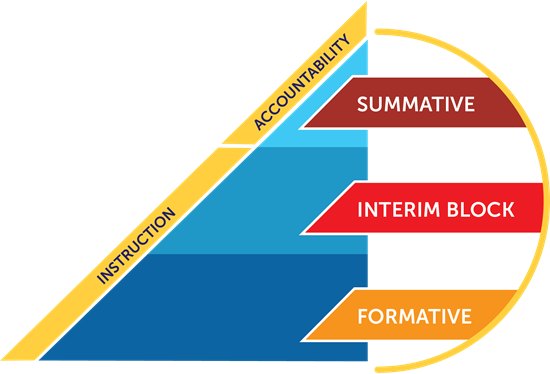Overview

This image is an adaption of a graphic originally developed by Perie, Marion, Gong, and Wurtzel(2007)
Connecticut’s assessment system is designed to support student learning of the Connecticut Core Standards and the Next Generation Science Standards. The system is balanced and comprehensive. It offers different tools for various purposes. Formative assessment resources and Interim Block assessments are designed to support instruction and monitor progress during the year. Summative assessments evaluate overall academic achievement at the end of the year and are designed to inform accountability, evaluation, and support.

Formative Assessment is a process used by teachers and students during instruction in every class throughout the school year. This process of Formative Assessment drives instructional practices to increase student access, application, and attainment of academic skills.
Formative Assessments:
- are embedded by teachers within learning activities as a quick check up to gauge student learning and understanding.
- are aligned to grade-level standards and linked directly to current instruction.
- provide immediate information on important skills and concepts that the student learned and those concepts in which extra teaching is needed.

Interim Assessment Blocks are short assessments that help teachers to:
- check student progress.
- gather information about learning.
- alter instruction.
Interim Block Assessments are flexible tools that can be used in a variety of ways – as formal mini-assessments, as a class activity, or as a formative assessment tool — to measure students’ mastery of specific content and skills aligned.

Summative Assessments evaluate overall academic achievement at the end of the year and are designed to inform accountability, evaluation, and support. Results from these summative assessments in ELA, math, and science:
- are one valid and reliable indicator of academic achievement and progress attained by students (other important indicators that show student learning and growth include class work, classroom assessments, and report cards).
- tell policy makers if all students–regardless of zip code, family income, dominant language, or disability – are achieving and making progress academically.
- are suitable for use in district and state accountability systems, program/curriculum evaluations, and district/school identification for support and recognition.
Resources
- Tools for Teachers - This online collection of resources was written and vetted by educators nationally. All resources are aligned with the Common Core State Standards in math and ELA and were designed to support K-12 teachers in their use of the formative assessment process. Each ELA and math Interim Assessment Block has a corresponding Connections Playlist, created to support struggling students and to enhance learning for students who are scoring above standard as well.Instructional resources include lessons that can be used as a follow up to an interim, or they can be used to supplement existing curriculum.
- The Types and Purposes of Student Assessment in Education: An FAQ
- Sensible Assessment Practices- The purpose of this document is to offer guidance to educators including general education teachers, special education teachers, interventionists, instructional specialists, and related service providers on how they can “assess” their incoming students when the new school year begins without necessarily having to “test” them.
